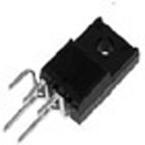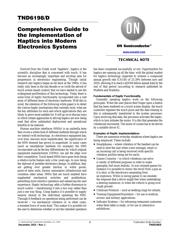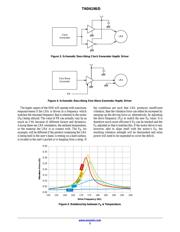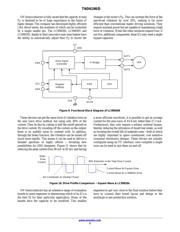herunterladen

© Semiconductor Components Industries, LLC, 2015
December, 2015 − Rev. 1
1 Publication Order Number:
TND6198/D
TND6198/D
Comprehensive Guide to
the Implementation of
Haptics into Modern
Electronics Systems
Derived from the Greek word ‘haptikós’, haptics is the
scientific discipline that is concerned with touch. It has
become an increasingly important and exciting area for
progression in electronics engineering. Though initial
research into haptics began as far back as the 1960s, it has
really only been in the last decade or so (with the advent of
touch screen based control) that we have started to see the
widespread proliferation of this technology. Today there is
some form of haptic functionality incorporated into a vast
array of different items of electronic hardware. With this in
mind, the intention of the following white paper is to detail
the various haptic mechanisms that currently exist, what are
the key attributes for each and which applications they are
likely to prove most suitable for. It will go on to discuss ways
in which certain approaches to driving haptics are now being
used that allow substantial deployment and operational
benefits to be realized.
Human machine interfaces (HMIs) is an umbrella term
that covers a whole host of different methods through which
we interact with technology. As electronics equipment has,
over time, become more sophisticated, the significance of
the HMI element has grown in magnitude. In many cases
(such as smartphone handsets for example) the HMI
incorporated can be the key differentiator by which original
equipment manufacturers (OEMs) can get the edge over
their competition. Touch based HMIs have gone from being
a relative niche feature only a few years ago, to now being
the stalwart of portable electronics design. In addition, they
are getting ever greater traction in white goods,
point-of-sales units, factory automation infrastructure and
countless other areas. HMIs that are touch enabled have
supplanted mechanical switches and pushbuttons,
permitting more intuitive operation and enhancing the user
experience. Haptic technology adds a further dimension to
touch control − transforming it into a two way rather than
just a one way thing. Using haptics it is possible to supply
sensory stimuli to the individual operating the HMI.
Through it feedback on operations being performed can be
received − via mechanical vibration or, in other cases,
a resistant force of some kind. This makes it is possible for
the user to determine whether or not the intended operation
has been completed successfully or not. Opportunities for
haptics are opening up all the time, with the global market
for haptics technology expected to witness a compound
annual growth rate (CAGR) of 25.39% between now and
2020, allowing it to reach a $29.84 billion annual total by the
end of that period (according to research published by
Markets and Markets).
Fundamentals of Haptic Functionality
Generally speaking haptics work on the following
principals. When the user places their finger upon a button
that has been rendered on a touch screen display, the touch
controller registers the touch point and the data relating to
this is subsequently transferred to the system processor.
Upon receiving that data, the processor activates the haptic,
which in turn initiates the motor. It is this that generates the
vibrational movement. The motor of course has to be driven
by a suitable driver IC.
Examples of Haptic Implementations
There are numerous everyday situations where haptics are
being employed. These include:
• Smartphones − where vibration of the handset can be
used to alert the user when a text message, email or
an incoming call is being received (with specific
vibration profiles being set for each).
• Games Consoles − in which vibrations can serve
a variety of different purposes in order to make
gameplay feel more realistic. In war oriented games for
instance it is possible to mimic the recoil from a gun as
it is shot, or the shockwave emanating from
an explosion. While in racing games it can emulate
the response that a driver might feel when undertaking
a steering maneuver, or when the vehicle is going over
rough ground.
• Childcare Products − such as teething rings for infants.
• Training Equipment/Simulators − for use in medical,
avionic and military applications.
• Indicator Systems − for informing restaurant customers
when there table is ready, or for use in interactive
exhibitions.
www.onsemi.com
TECHNICAL NOTE
Verzeichnis








